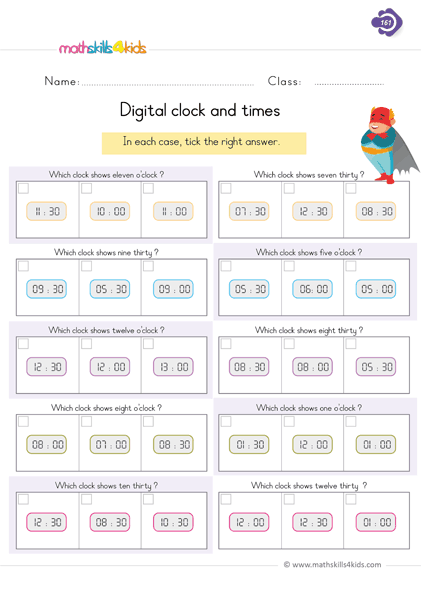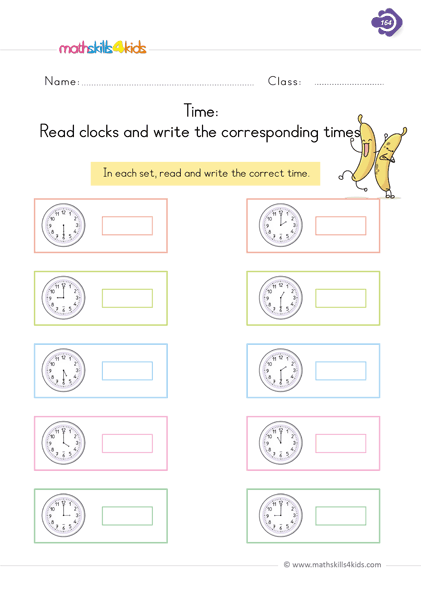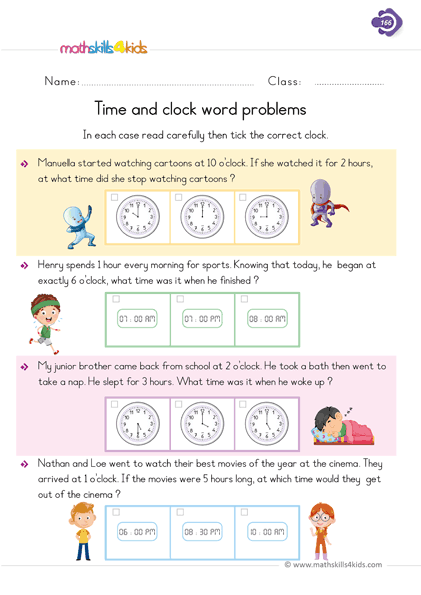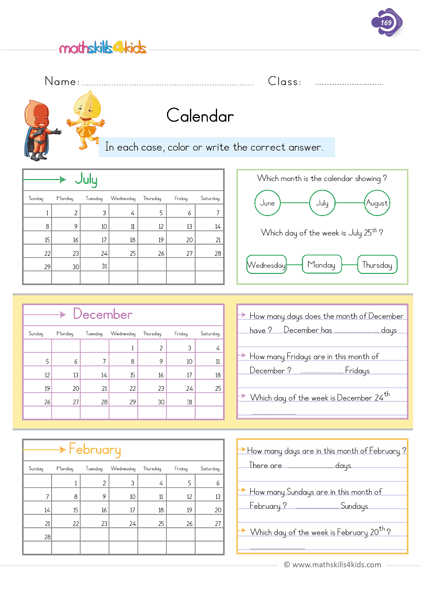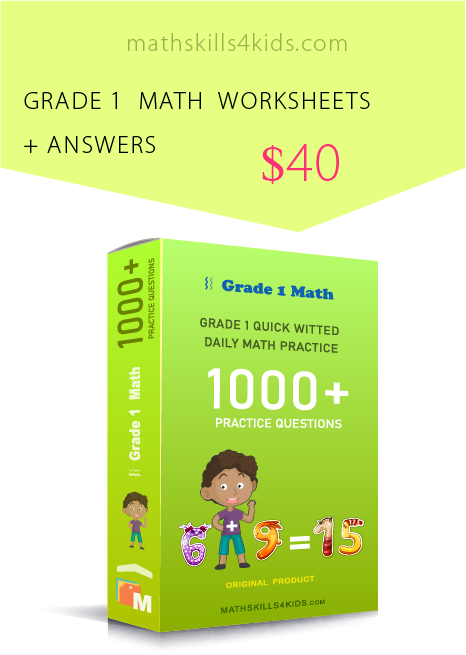Easy-to-use printable telling time worksheets for 1st Grade
-
Are you looking for a fun and effective way to help your child learn how to tell time? If so, you've come to the right place! In this resource, we'll share some amazing printable telling time worksheets perfect for 1st graders. These time-telling worksheets from Mathskills4kids comprise everything you need to know about time-telling. They are downloadable, printable, and easy to use in the classroom and at home.
Learning to tell time is an essential skill for young children but can be challenging. That's why we have created these easy-to-use printable time worksheets that will make learning to tell time fun and engaging for your first grader.
With these worksheets, your child will be able to master the basics of telling time, such as reading analog and digital clocks, understanding AM and PM, and using time-related vocabulary.
So, let's start exploring this fantastic resource while you enjoy your child reading and telling time like a pro in no time!
Why telling time is an essential skill for 1st Graders
Telling time is one of the most important skills that your child will learn in 1st Grade. Not only is it an essential math skill that supports other concepts like fractions and measurement, but it is also a life skill that your child will use daily.
By learning how to tell time, your child will be able to:
- Plan and organize their daily activities and routines
- Develop a sense of responsibility and independence
- Understand the concept of duration and elapsed time
- Appreciate the value of time and use it wisely
- Communicate effectively with others about time-related topics
-
BROWSE THE WEBSITE
-
DOWNLOAD FREE WORKSHEETS
-
-
1st GRADE MATH TOPICS
- Counting and numbers
- Understand addition
- Addition skills
- Addition exercises
- Addition strategies
- Understand subtraction
- Subtraction skills
- Subtraction Exercises
- Subtraction strategies
- Mixed operation
- Comparing numbers up to 100
- Estimation Worksheets
- Place value
- Spatial sense
- Graphing & data
- Measurement
- Patterns
- Probability
- Sorting & classifying
- Telling time
- 2D shapes
- 3D shapes - Solids figures
- Fractions
-
-
How to introduce telling time concepts to your child
Before you start using the printable telling time worksheets, you must ensure that your child has a solid foundation of the basic concepts of telling time. Here are some tips on how to introduce telling time concepts to your child:
- Start with familiar events and routines. For example, you can ask your child when they wake up, have breakfast, go to school, etc.
You can also use a calendar or a daily schedule to show them how different activities happen at different times of the day.
- Use a variety of clocks and timers. You can use analog clocks, digital clocks, watches, timers, or even your phone to show your child how time is displayed differently.
You can also point out the features of each clock, such as the hour hand, the minute hand, the numbers, the colon, etc.
- Teach them the vocabulary of telling time. You can use words like hour, minute, second, o'clock, half past, quarter past, quarter to, etc., to describe the time.
You can also use words like morning, afternoon, evening, night, today, tomorrow, yesterday, etc., to talk about different parts of the day.
- Make connections between time and other concepts. You can help your child understand how time relates to other math concepts like fractions and measurement. For example;
You can show them how an hour is divided into 60 minutes, how a minute is divided into 60 seconds, how a half hour equals 30 minutes or 2/4 of an hour, etc.
- Start with familiar events and routines. For example, you can ask your child when they wake up, have breakfast, go to school, etc.
-
The benefits of using printable telling time worksheets
Once your child understands the basic concepts of telling time, you can use the printable telling time worksheets to reinforce their learning and practice their skills. Here are some of the benefits of using these worksheets:
- They are aligned with the common core standards for 1st Grade math.
This means that they cover all the topics and skills that your child needs to learn in 1st Grade according to the national curriculum.
- They are differentiated for different levels and needs. You can choose from various worksheets that suit your child's level and learning style. For example;
You can find worksheets that focus on reading analog or digital clocks only or worksheets that mix both clocks.
You can also find worksheets that have different levels of difficulty or complexity.
- They are engaging and fun. The worksheets are designed to capture your child's interest and motivation by using colorful graphics, cute characters, and fun themes.
They also include games and puzzles that make telling time more enjoyable and challenging.
- They are easy to use and print. The worksheets are in PDF format that you can easily download and print at home.
You can also print multiple copies or laminate them for repeated use.
- They are aligned with the common core standards for 1st Grade math.
-
Tips and tricks to make telling time fun and engaging
Using the printable telling time worksheets is a great way to help your child learn how to tell time, but you can also supplement them with other activities and resources that make telling time more fun and engaging.
Here are some tips and tricks that you can try:
- Use real-life situations and scenarios. You can create or find stories or problems that involve telling time in real-life contexts. For example;
You can ask your child how long it takes them to do specific tasks or activities or what time they must leave home to catch the bus or meet their friends.
- Use songs and videos. You can use songs and videos that teach or reinforce telling time concepts and vocabulary. For example;
You can use songs like "What Time Is It?" by Jack Hartmann or "Telling Time Song" by The Singing Walrus.
You can also use videos like "Telling Time for Children - Learning the Clock" by Math & Learning Videos 4 Kids or "Learn to Tell Time #1 | Telling the Time Practice for Children | What's the Time? | Fun Kids English" by Fun Kids English.
- Use games and apps. You can use games and apps that make telling time more interactive and fun. For example;
You can use games like "Telling Time Quiz" by Education.com or "Telling Time Bingo" by ABCya.
You can also use apps like "Telling Time - Clock Games" by RV AppStudios or "Toca Life: World" by Toca Boca.
- Use real-life situations and scenarios. You can create or find stories or problems that involve telling time in real-life contexts. For example;
-
A Variety of printable telling time worksheets for different levels and needs
Now that you know why telling time is an essential skill for 1st graders, how to introduce telling time concepts to your child, the benefits of using printable telling time worksheets, and some tips and tricks to make telling time fun and engaging, you're ready to start using the worksheets!
Below, you'll find a variety of printable telling time worksheets suitable for different levels and needs.
You can browse them and choose the ones matching your child's level and learning style. You can also mix and match them to create your own custom telling time practice.
- Reading analog clock worksheets: One of the best ways to help your first grader learn to tell time is by reading analog clocks. These clocks have hands that move around the face of the clock, indicating the hours and minutes.These hands guide reading time in different intervals, such as an hour, half an hour, quarter hour, five minutes, or one minute. Note that our printable worksheets include analog clocks with different times, so your child can practice reading and telling time in various scenarios.
They also include word problems that require your child to apply their telling time skills in real-life situations.
- Reading digital clocks worksheets: While analog clocks are essential for learning to tell time, it's also important for first graders to practice reading digital clocks.
These digital clock worksheets help your child practice reading time with different formats, such as 12-hour or 24-hour.
They also include word problems that require your child to apply their telling time skills in real-life situations.
- Reading mixed clocks worksheets: These worksheets help your child practice reading both analog and digital clocks with different intervals and formats.
These reading mixed clocks worksheets consist of fun activities to help young math learners become comfortable with telling time in any situation.
They also include word problems that require your child to apply their telling time skills in real-life situations.
- Drawing hands-on clocks worksheets: These worksheets help your child practice drawing hands-on analog clocks to show the given time.
They also include word problems that require your child to apply their telling time skills in real-life situations.
- Writing time in words worksheets: These worksheets help your child practice writing time in words using the correct vocabulary and spelling.
They also include word problems that require your child to apply their telling time skills in real-life situations.
- Matching time worksheets: These worksheets help your child practice matching different ways of showing the same time, such as analog clocks, digital clocks, words, or fractions.
They also include word problems that require your child to apply their telling time skills in real-life situations.
- Comparing time worksheets: These worksheets help your child practice comparing two times using words like before, after, earlier, later, etc.
They also include word problems that require your child to apply their telling time skills in real-life situations.
- Ordering time worksheets: These worksheets help your child practice ordering three or more times from earliest to latest or vice versa.
They also include word problems that require your child to apply their telling time skills in real-life situations.
- Elapsed time worksheets: These worksheets help your child practice finding the elapsed time between two given times using words like hours, minutes, seconds, etc.
They also include word problems that require your child to apply their telling time skills in real-life situations.
- Time Word Problems: Our printable telling time worksheets for 1st Grade include time word problem These problems help children apply their knowledge of telling time to real-life situations. For example;
Kids may be asked to calculate how long it takes to complete a task or how much time has passed between two events.
These word problems reinforce time-telling skills and help develop critical thinking and problem-solving abilities.
- Reading analog clock worksheets: One of the best ways to help your first grader learn to tell time is by reading analog clocks. These clocks have hands that move around the face of the clock, indicating the hours and minutes.These hands guide reading time in different intervals, such as an hour, half an hour, quarter hour, five minutes, or one minute. Note that our printable worksheets include analog clocks with different times, so your child can practice reading and telling time in various scenarios.
-
How to track your child's progress and provide feedback
One of the best ways to help your child learn is to track their progress and provide feedback. By so doing, you will be able to assess their understanding of the material and motivate them to keep practicing and improving their skills.
This review section includes questions that cover the basics of telling time, such as identifying the hour and minute hands on a clock and reading digital clocks.
You can use these printable telling time worksheets for 1st Grade to track your child's progress and provide feedback. Here are some tips on how to do that:
- Please print out the worksheets and have your child complete them independently.
- Check their answers using the answer keys provided at the end of each worksheet.
- Praise your child for correct answers and encourage them to try again if they make mistakes.
- Use a sticker chart or a reward system to celebrate your child's achievements and milestones.
- Review the worksheets with your child and discuss what they learned and what they need to work on.
Bonus: More resources and activities for telling time practice
If you're looking for more resources and activities for telling time practice, you're in luck! There are plenty of online and offline options to choose from.
Here are some of our favorites:
- Online games: Many online games teach telling time in a fun and interactive way. Some of them are Time Practice, Time Quiz, On the Hour, On the Half Hour, Telling Time to the Quarter Hour, and Telling Time: Showtime!
- Books: Reading books about telling time can help your child learn new vocabulary and concepts. Some are What Time Is It, Mr. Crocodile?, The Grouchy Ladybug, Telling Time with Big Mama Cat, and Clocks and More Clocks.
- Crafts: Making crafts related to telling time can spark your child's creativity and imagination. Some are Make a Clock, Paper Plate Clock, Sundial, and Cuckoo Clock.
- Songs: Singing songs about telling time can help your child remember the rules and patterns. Some of them are Hickory Dickory Dock, What Time Is It? The Clock Song, and The Months of the Year Song.
Thank you for sharing the links of MathSkills4Kids.com with your loved ones. Your choice is greatly appreciated.
We hope you enjoyed this article about easy-to-use printable telling time worksheets for 1st Grade.
These worksheets are a great way to help your child learn how to tell time in a fun and engaging way.
Try them out today and see how much your child will love them!
Happy learning!
Useful links
Telling time worksheets for 1st grade | homeschoolmath.net :
https://www.homeschoolmath.net/worksheets/grade1/telling_time_worksheets_gr1.php1st Grade Telling Time Worksheets | K5 Learning :
https://www.k5learning.com/free-math-worksheets/first-grade-1/telling-timeTelling Time FREEBIE! by Benzel's Beginnings | TPT (teacherspayteachers.com) :
https://www.teacherspayteachers.com/Product/Telling-Time-FREEBIE-3734084 -
